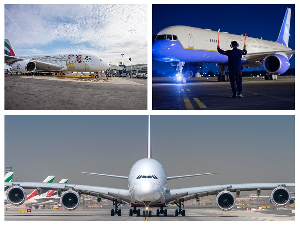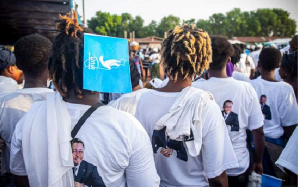- Home - News
- TWI News | TV
- Polls
- Year In Review
- News Archive
- Crime & Punishment
- Politics
- Regional
- Editorial
- Health
- Ghanaians Abroad
- Tabloid
- Africa
- Religion
- Election 2020
- Coronavirus
- News Videos | TV
- Photo Archives
- News Headlines
- Press Release
Business News of Tuesday, 14 June 2016
Source: B&FT
New airline: Gov’t seeks experienced airline operator
Government is seeking an experienced airline operator as a strategic partner to establish a new national airline for the country.
The Ministry of Transport, in an Expression of Interest (EOI) published in local newspapers, said: “The feasibility studies [for the establishment of a new national carrier] also demonstrated the new national airline will require partnership with an experienced strategic airline partner that has a global distribution network to adequately take advantage of opportunities in the market place”.
The partner, the EOI notes, ought to have good financial strength; technical strength in areas of IT systems and flight operations; maintenance yield and capacity management; good distribution network; and be a member of a global alliance.
These requirements effectively eliminate indigenous airlines that had expressed interest to partner government in establishing a new flag-carrier -- given their network and financial strength at the moment.
Africa World Airlines (AWA) and Starbow, the only remaining main indigenous airlines, do not currently have large enough networks that could put them in the running as a partner in this new endeavour.
Africa World Airlines, which had previously expressed keen interest in partnering government in this new enterprise, operates flights from Accra to Kumasi, Accra-Tamale, Kumasi-Tamale, Tamale-Kumasi, and a regional flight to Lagos.
Abuja and Port Harcourt in Nigeria; Liberia, and Senegal are a few of the routes earmarked by the airline following completion of the stringent International Operational Safety Audit Programme (IOSA).
The IOSA certification audit is an internationally recognised and accepted evaluation system designed to assess the operational, management and control systems of an airline, with emphasis on universally accepted best practices in the airline industry.
AWA was subsequently listed as an IOSA-registered airline by the International Air Transport Association (IATA) in May 2015.
Despite its strategic partnership with South African Airways, which has made it possible for passengers in Nigeria to travel on AWA from Lagos and connect an SAA flight to the USA from Accra, AWA’s routes are not far-reaching enough going by the EOI published.
IOSA-certified Starbow, which operates flights to all domestic destinations in the country, has the needed designation to fly to many destinations on the West Coast.
Expecting to take delivery of new aircraft, the airline is intends to re-commence regional flights soon -- after its initial foray was curtailed by various challenges.
Both AWA and Starbow, are not yet members of global alliances such as Star Alliance, SkyTeam and Oneworld.
What the figures say
Airlines on the continent are expected to incur huge losses this year, brought on by intense competition in long-haul routes, political barriers to growing intra-Africa traffic, high costs and infrastructure deficiencies, the International Air Transport Association (IATA) 2016 financial outlook has revealed.
“African airlines are expected to post a US$500million loss in 2016, a slight improvement on the US$700million that the region’s carriers lost in 2015.
“Capacity growth (5.3%) is anticipated to outpace demand growth of 4.5%. Carriers in the region continue to confront a plethora of challenges including intense competition on long-haul routes, political barriers to growing intra-Africa traffic, high costs and infrastructure deficiencies.
“In addition, many major economies in the continent have been hit hard by the collapse of commodity prices -- and the impact this has had on revenues and the inflow of hard currencies. Unresolved foreign exchange crises are adding to the economic difficulties facing airlines in this region,” the report noted.
Airlines in the West African sub-region are currently constrained by challenging economic situations in many of the 16 West African countries.
Nigeria, the region’s largest economy, is reported to have contracted for the first time since 2004.
Bloomberg reports that the populous West African economy’s foreign-currency reserves have slipped to US$26.4billion, the lowest in more than a decade.
The news agency reports that the central bank has restricted access to foreign exchange following dwindling oil revenues. The country’s currency also fell to about 370 per dollar last week.
This has affected the passenger throughput of most airlines within the region which ply the Lagos or Abuja route, the most profitable in the region. Some airlines have pulled out of the route temporarily.
Ghana Airports Company data shows that international passenger throughput dropped by some 9 percent; from about 1.65million in 2014 to 1.5million as at December 2015.
Despite these challenges, the continent foresees growth for existing and new airlines that operate intra-Africa and long-haul flights into Africa from Europe, Asia, and North America.
The proposed new airline will also benefit from the bilateral agreements Ghana has with many home countries of airlines that fly into Ghana.
The success of the proposed new national airline will also heavily depend on the new entity’s structure.
Structure of new airline
After the collapse of Ghana Airways, the former national flag-carrier, government invited private participation in the establishment of a new national airline.
In 2004 Ghana International Airlines was established, with 70 percent shares held by GoG and 30 percent held by a US consortium GIA-USA. Faced by a myriad of issues, the airline went down in 2010.
This brings into view the issue of ownership in the proposed new national carrier. The days of state-run airlines are long gone. Private management and capital is extremely important in an industry that is capital intensive but with very little margins.
The Transport Ministry has said government is not going to commit funds but will only seek a carried interest in the proposed new airline. Some experts have however questioned this.
“In an industry that requires huge financial outlay, who should commit all the capital needed for this to succeed?” an airline operator asked the B&FT.
Another also believes that the new airline should rather look inward and dominate the continent before venturing to other long-haul routes.
The structure of the proposed new flag-carrier is currently imprecise. Interested parties however have until June 24 to make their interest known.










